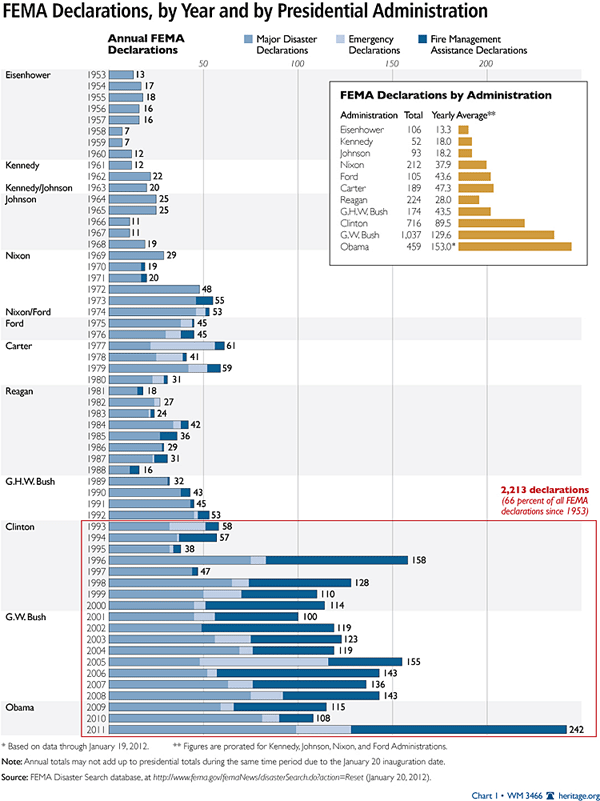After three full years (January 20, 2009, to January 19, 2012), it is clear that the Obama Administration has adopted the views of the Clinton and Bush Administrations on how to use the Federal Emergency Management Agency (FEMA) as a political pork-barrel spending agency. In 2011, the Obama Administration shattered—an understatement if there ever was one—the records for:
- The total number of FEMA declarations: 242 versus 158 set in the 1996 election year;
- The number of Major Disaster Declarations (MDDs): 99 versus 75 set in 1996 and 2008; and
- The number of Fire Management Assistance Declarations (FMADs): 114 versus 86 set in 2006.
It also posted the third-highest number of Emergency Declarations (EDs) in FEMA history—29 versus 68 set in 2005, the year of Hurricane Katrina. These records fell despite the absence of any successful terrorist attacks, any Category 2 or higher hurricanes, or any earthquakes greater than 6.0 on the Richter Scale.
Congress should either limit the use of FEMA declarations or accept the near total federalization of disasters and the federal fiscal cost that goes with that reality.
A Historical View of FEMA Declarations
As the chart below shows, the federalization of natural disasters began its dramatic increase in 1993 with the election of Bill Clinton and the appointment of a state official, James Lee Witt, as FEMA’s administrator for the first time. In his reelection year, President Clinton issued 158 declarations, which broke the record of 61 declarations that had stood since 1977. That same year, he issued 75 MDDs, which was a 56 percent increase over the 1972 record of 48 declarations, and 75 FMADs, which more than tripled the previous record of 20 he set in 1994.
In just eight years, President Clinton issued a whopping 716 FEMA declarations, encompassing 62 percent of all FEMA declarations from 1953 to 1993. Clinton’s yearly average of FEMA declarations was 89.5 declarations, more than doubling President George H. W. Bush’s yearly average (43.5) and tripling President Ronald Reagan’s yearly average (28). Other than under Reagan, since 1953, the yearly average has increased every presidential term.
Not to be outdone, President George W. Bush raised the bar even higher by finishing his eight years having issued 1,037 declarations, or 129.6 per year. He managed to break Clinton’s record of FMADs by 11 declarations in 2006 and tied the record for MDDs in 2008. He set the record for the number of EDs at 68 in 2005 when the response to Hurricane Katrina involved nearly every state. Bush’s declaration total represents a full 31 percent of all FEMA declarations from 1953 to today.
Though President Obama started off slowly, relatively speaking, with 108 declarations in each of his first two years, he did break the record of MDDs by posting 81 declarations in 2010. The wheels came off in 2011. Obama eviscerated the record books by issuing 243 declarations in 2011, which included a record 100 MDDs and a record 114 FMADs. Obama’s three-year average stands at 153 declarations per year.
To truly put this figure in perspective, it means that somewhere in America in 2011, a disaster occurred every day and a half that required the intervention of the federal government because each of these disasters overwhelmed a state and its local governments. Most Americans would be hard-pressed to remember any disasters in the United States in 2011 other than Hurricane Irene (15 MDDs compared to four MDDs due to Hurricane Katrina), the Joplin tornado, and the Tuscaloosa tornado.
The Time for FEMA Reforms Has Come
With exploding federal deficits and perpetual draining of the Disaster Relief Fund, the federal government needs to end the federalization of disasters and get back to the balance that existed under Reagan and the first 206 years of American history. Specifically, Congress should:
- Modify the Stafford Act. As the litmus test for federal disaster dollars, the Stafford Act fails to accurately determine which disasters meet the federal requirements and which do not. Congress should establish clear requirements that limit the types of situations in which declarations can be issued—eliminating some types of disasters entirely from FEMA’s portfolio.
- Lower the cost-sharing provisions. Congress should reduce the cost-sharing provision for all FEMA declarations to no more than 25 percent of the costs. This will help to ensure that at least three-fourths of the costs of a disaster are borne by the taxpayers living where the disaster took place. For catastrophes with a nationwide impact, such as 9/11 and Hurricane Katrina, a relief provision could provide a higher federal cost share when the total costs of a disaster exceed a certain threshold amount.
- Overhaul existing FEMA processes and procedures. Under the public assistance program, which grants monies to state and local governments for disaster response, FEMA’s processes and procedures are not aligned with the primary focus of catastrophic disaster response: saving lives and property. The program should increase staff and training and include changes in its project worksheets to ensure that costs and damages are accurately assessed on the front end.
Stop the Federalization of Disasters
From 1953 to today, Presidents have issued 3,367 FEMA declarations. In just the past 19 years out of those 59 years, Presidents Clinton, Bush, and Obama have accounted for 2,213 FEMA declarations, or 66 percent. Global warming aside, this juxtaposition of figures indicates a far simpler explanation for the remarkable jump in federalized disasters: pork-barrel politics.
Congress should reform the fundamental problems with FEMA’s disaster-response framework and return power to state and local governments—even if they would gladly give up that power for federal funds. Political expediency and fiscal bailouts should never trump the Constitution.
Matt A. Mayer is a Visiting Fellow at The Heritage Foundation, president of Provisum Strategies, and author of Homeland Security and Federalism: Protecting America from Outside the Beltway.



